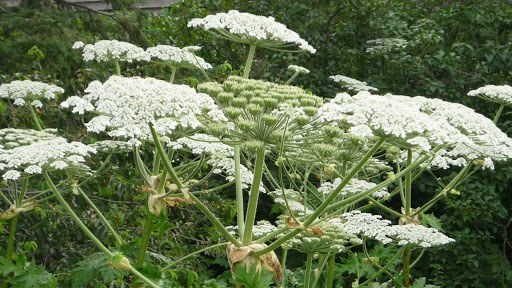Giant hogweed is an invasive plant species that can grow 12 feet tall and injure you if you touch it — but so far, scientists have not seen it in Saskatchewan.
A reader of the Moose Jaw Express submitted a picture of what looked like a giant hogweed plant growing in the ditch of Tatanka Drive at Buffalo Pound Lake. To find out what this plant was, the Express contacted the Saskatchewan Invasive Species Council to confirm whether this plant was indeed the dreaded Heracleum mantegazzianum.
After reviewing the picture, Chet Neufeld, executive director of the Native Plant Society of Saskatchewan and member of both the Saskatchewan and Canadian Invasive Species councils, quickly determined the plant was not giant hogweed but was instead cow parsnip, a plant native to Saskatchewan.
“I get 50 to 100 emails every summer on this,” he chuckled.
These two plants belong to the same genus, or family, which is why they look similar, Neufeld explained. Some people will react after touching cow parsnip and develop a rash, which usually causes them to think it’s giant hogweed. However, there are several plants that can have that effect on skin.
The Native Plant Society of Saskatchewan and Saskatchewan Invasive Species Council appreciate receiving these calls or emails since it means the information about giant hogweed is sticking in people’s minds and they are on the lookout for it, he continued. He would rather receive 100 emails about possible sightings that turn out to be cow parsnips than one giant hogweed that is missed.
“With new invasive species coming into the province, we really have one chance — and that’s a very small window — to act on it and eradicate it before it spreads across the province and then we’re stuck with it forever,” said Neufeld.
An invasive species that arrived in Saskatchewan and was not detected is leafy spurge, while a species called salt cedar was discovered and quickly eradicated.
So far giant hogweed has not reached the Prairies and instead is mainly found in the lower mainland of British Columbia and Ontario. In B.C., because of the climate, it can grow to be 12 feet tall and have large leaves that can damage the skin. Specifically, it can cause painful blisters and lead to temporary blindness if the plant’s juices get in your eyes.
There are two ways to get rid of giant hogweed, Neufeld explained. If the plant is small, then you should dig up the plant — including the roots — and throw it in the garbage. You should also wear long-sleeved shirts and long pants, gloves, and eye protection when doing this.
However, if the plant is much larger and you can’t dig it up, you should call a professional to take care of it. This includes phoning the office of the nearest rural municipality or even city hall.
“I’m hesitant to tell them to chop it down because of the juices that can get on you,” said Neufeld.
If people are uncertain of what the plant is, they can email a picture to Neufeld at [email protected]. If he confirms that the plant is giant hogweed, he can also notify the proper authorities, including RM offices or even the province.
“If it was giant hogweed,” he added, “we would move very, very quickly to eradicate it.”




